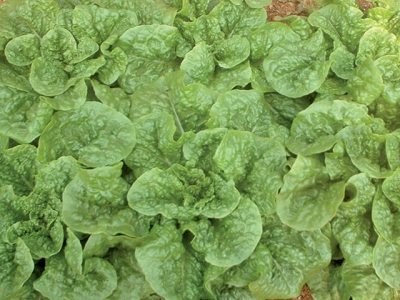Interesting facts about lettuce

Lettuce has its origin in the eastern Mediterranean and has been cultivated for thousands of years. It is part of the daisy family Asteraceae, and the range of varieties is increasing at an astonishing rate as the world becomes more ‘salad-conscious’.
Leaf types such as this are perfect for the home garden. Photo: Bill Kerr
The Latin name is Lactuca sativa. ‘Lactuca’ means ‘milk forming’. When the stem or midrib is cut, a sticky white milk oozes from the wound. Sativa simply means ‘common’.
As with most vegetables, lettuce has changed substantially as growers have made selections to suit their preferences over the centuries.
Wild species are rather bitter, a trait found to this day in certain varieties and under stress conditions. (Some consumers like a touch of bitterness, as found in endives, for example.)
Many modern varieties of lettuce are almost free of bitterness, even after stressed growing conditions.
Types of lettuce
Selection over the centuries has resulted in four main groups:
- crisphead lettuce;
- butterhead lettuce;
- cos or romaine (different names for the same product);
- and loose-leaf types.
South Africans mostly prefer crisphead lettuce, while loose-leaf lettuce tends to be planted in all countries, but does not dominate the market.
In the past, crisphead lettuce in South Africa was sold loose and usually sent to the market in second-hand banana cartons.
The lettuce’s large outer leaves were sold with the head and afforded some protection until discarded in the kitchen.
Gradually, this type is giving way to wrapped prepacked lettuce, where only the usable head is sold.
Crispheads are widely referred to as ‘iceberg lettuces’ and an old variety is still called ‘Iceberg’.
This caused some confusion in the past when growers would announce that they were growing iceberg lettuces, referring to the generic term, while buyers assumed they were referring to the specific variety.
Iceberg types produce a rather hard head which becomes a lighter colour with age, and more bitter.
Some consumers still look for the hardest head, thinking they’re getting more for their money. In fact, they are taking home an inferior, less nutritious product and often end up with fewer leaves in the salad bowl.
I once watched harvesters in California pushing down on each lettuce with the flat of the hand; if the lettuce was hard, it was deemed inferior and left on the land.
Salad packs
Although often part of lettuce salad packs, cos types are not very popular in South Africa. Yet leafy lettuces are far more nutritious than the crisphead type.
Cos types do not make heads. Instead, they form a rosette of leaves in a vertical column which can be quite compact in some varieties.
Popular in parts of Europe, butter lettuces have a velvety, soft texture and usually make some sort of head, although not in all cases.
They take a little getting used to if you’re accustomed to crisp leaves. In South Africa, they tend to be used as components of leaf lettuce packs rather than being sold separately.
Every shape, size and colour
Loose-leaf types come in a diversity of colours, leaf shapes and leaf profiles. They may be smooth, crinkled, blistered, serrated and of different sizes.
This makes them ideal for leaf packs as the different colours and leaf shapes are attractive in a salad.
Moreover, these types have a good ‘mouth feel’, as it’s known in the trade. Diversity also results in a greater nutrient composition.
At the same time, loose-leaf lettuces are becoming more popular in home gardens. They reach the harvest stage quickly, and by picking the lower leaves and then moving on to the next rosette, you can utilise one planting for months.
Loose-leaf lettuces are all I grow at home and I can get salad leaves any day of the year with little effort.
With heading and even cos types, there is a limited window of opportunity to harvest, making them less practical in the garden.
Related news
Tools

Phối trộn thức ăn chăn nuôi

Pha dung dịch thủy canh

Định mức cho tôm ăn

Phối trộn phân bón NPK

Xác định tỷ lệ tôm sống

Chuyển đổi đơn vị phân bón

Xác định công suất sục khí

Chuyển đổi đơn vị tôm

Tính diện tích nhà kính

Tính thể tích ao



 How lettuce production has changed
How lettuce production has changed  Beating cucurbit viruses
Beating cucurbit viruses